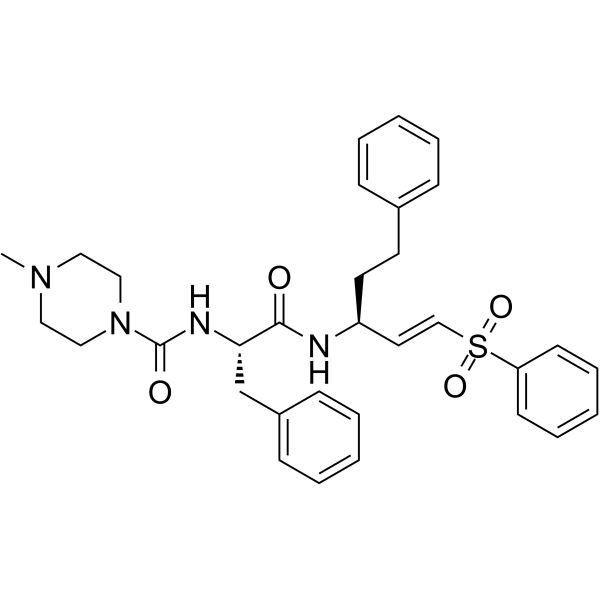上海金畔生物科技有限公司为生命科学和医药研发人员提供生物活性分子抑制剂、激动剂、特异性抑制剂、化合物库、重组蛋白,专注于信号通路和疾病研究领域。
K777 纯度: 99.60%
K777 是一种有效的,口服活性且不可逆的半胱氨酸蛋白酶 (cysteine protease) 抑制剂,也是一种有效的 CYP3A4 抑制剂,IC50 为 60 nM,是一种选择性的 CCR4 拮抗剂,具有强的趋化性抑制作用。K777 不可逆地抑制锥虫(克鲁斯锥虫的主要半胱氨酸蛋白酶)和组织蛋白酶 B 和 L。K777 是一种广谱抗病毒药物,通过靶向组织蛋白酶介导的细胞进入。K777 抑制 SARS-CoV 和 EBOV 病毒的进入,IC50 值分别为 0.68 nM 和 0.87 nM。

K777 Chemical Structure
CAS No. : 233277-99-1
| 规格 | 价格 | 是否有货 | 数量 |
|---|---|---|---|
| 5 mg | ¥3800 | In-stock | |
| 10 mg | ¥6400 | In-stock | |
| 25 mg | ¥13200 | In-stock | |
| 50 mg | 询价 | ||
| 100 mg | 询价 |
* Please select Quantity before adding items.
K777 相关产品
•相关化合物库:
- Covalent Screening Library Plus
- Bioactive Compound Library Plus
- Anti-Infection Compound Library
- GPCR/G Protein Compound Library
- Immunology/Inflammation Compound Library
- Metabolism/Protease Compound Library
- Anti-Cancer Compound Library
- Small Molecule Immuno-Oncology Compound Library
- Anti-Aging Compound Library
- Covalent Screening Library
- Antioxidants Compound Library
- Oxygen Sensing Compound Library
- Angiogenesis Related Compound Library
| 生物活性 |
K777 is a potent, orally active and irreversible cysteine protease inhibitor. K777 is also a potent CYP3A4 inhibitor with an IC50 of 60 nM and a selective CCR4 antagonist featuring the potent chemotaxis inhibition. K777 irreversibly inhibits Cruzain, the major cysteine protease of Trypansoma cruzi, and cathepsins B and L. K777 is a broad-spectrum antiviral by targeting cathepsin-mediated cell entry. K777 inhibits SARS-CoV and EBOV pseudovirus entry with IC50 values of 0.68 nM and 0.87 nM, respectively[1][2][3]. |
IC50 & Target |
Cysteine protease[1][2][3] |
||||||||||||||
|---|---|---|---|---|---|---|---|---|---|---|---|---|---|---|---|---|---|
| 体外研究 (In Vitro) |
K777 (K11777) can inhibit entry driven by other viral envelope proteins, HIV-based pseudotypes bearing spikes from coronaviruses (SARS-CoV, HCoV-229E, NL63, MERS-CoV) or glycoproteins from filoviruses (EBOV, SUDV, TAFV, RESTV, BEBOV and MARV) are examined. K777 inhibits SARS-CoV, HCoV-229E, NL63, MERS-CoV, EBOV, SUDV, TAFV, RESTV, BEBOV, MARV and Nipah pseudovirus entry with IC50 values of 0.68 nM, 1.48 nM, 6.78 nM, 46.12 nM, 0.87 nM, 1.14 nM, 2.26 nM, 3.37 nM, 5.91 nM, 1.9 nM and 0.42 nM, respectively. In contrast, 100 nM K777 does not inhibit infection mediated by envelope glycoproteins from an alphavirus (CHIKV), a rhabdovirus (VSV), a flavivirus (HCV), the retroviruses MLV-A and XMRV or two arenaviruses, Lassa and Junin virus[1]. 上海金畔生物科技有限公司 has not independently confirmed the accuracy of these methods. They are for reference only. |
||||||||||||||||
| 体内研究 (In Vivo) |
K777 (K11777; 35-105 mg/kg; oral administration; twice a day; for 10 days; C57BL/6 IFN-γR-KO mice) treatment rescues mice from otherwise lethal infections[4] . 上海金畔生物科技有限公司 has not independently confirmed the accuracy of these methods. They are for reference only.
|
||||||||||||||||
| 分子量 |
574.73 |
||||||||||||||||
| Formula |
C32H38N4O4S |
||||||||||||||||
| CAS 号 |
233277-99-1 |
||||||||||||||||
| 运输条件 |
Room temperature in continental US; may vary elsewhere. |
||||||||||||||||
| 储存方式 |
|
||||||||||||||||
| 溶解性数据 |
In Vitro:
DMSO : 100 mg/mL (173.99 mM; Need ultrasonic) 配制储备液
*
请根据产品在不同溶剂中的溶解度选择合适的溶剂配制储备液;一旦配成溶液,请分装保存,避免反复冻融造成的产品失效。 In Vivo:
请根据您的实验动物和给药方式选择适当的溶解方案。以下溶解方案都请先按照 In Vitro 方式配制澄清的储备液,再依次添加助溶剂: ——为保证实验结果的可靠性,澄清的储备液可以根据储存条件,适当保存;体内实验的工作液,建议您现用现配,当天使用; 以下溶剂前显示的百
|
||||||||||||||||
| 参考文献 |
|
所有产品仅用作科学研究或药证申报,我们不为任何个人用途提供产品和服务
